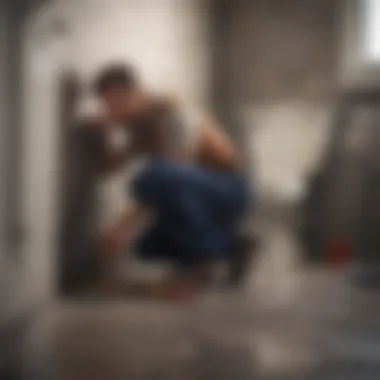Effective Methods for Removing a Toilet to Unclog


Intro
Addressing a clogged toilet can be a frustrating experience, particularly when conventional methods like plunging do not yield results. In more severe cases, removing the toilet may be the most effective solution. This process, while it might seem daunting, can be managed with the right tools and techniques. A systematic approach not only ensures a successful unclogging but also minimizes potential damage to your plumbing.
This guide aims to provide a thorough overview of the effective methods for removing a toilet in order to tackle severe blockages. It will highlight the essential tools, outline the steps involved, and discuss safety measures you need to keep in mind. The following sections will also share insights on reinstallation and advanced troubleshooting for persistent clogs.
Necessary Tools for the Task
Before diving into the removal process, it is important to gather the appropriate tools. Having everything ready will make the process smoother and less chaotic. Some of the tools you may need include:
- Adjustable wrench: Useful for loosening and tightening bolts.
- Screwdriver: Either flathead or Phillips, depending on the screws present.
- Plumber's putty: To create a watertight seal upon reinstallation.
- Plastic sheeting or tarp: To protect flooring from spills.
- Bucket: To catch excess water during removal.
- Gloves: To protect your hands from unsanitary conditions.
Steps for Toilet Removal
Removing a toilet requires a series of systematic steps. Follow these to ensure an effective and safe process:
- Turn off the water supply: Locate the shut-off valve behind the toilet and turn it clockwise.
- Drain the tank: Flush the toilet to empty the tank, then use a sponge or towel to soak up any remaining water.
- Disconnect the water line: Use an adjustable wrench to loosen the connector at the bottom of the tank.
- Unscrew the toilet: Look for the bolts at the base of the toilet. Typically, these are covered with caps that you can pry off.
- Lift the toilet: Once the screws are removed, rock the toilet gently back and forth to break the wax seal and lift the toilet straight up.
- Set the toilet aside: Place the toilet on a towel or plastic sheeting to prevent scratches or damage.
Removing the toilet can reveal blockages that are not accessible otherwise. Look out for foreign objects or excessive debris that may have caused the clog.
Safety Measures
Safety is an utmost priority during this venture. Here are some important safety tips:
- Always wear gloves to minimize contact with bacteria or waste.
- Ensure the working area is dry to prevent slips.
- Have a bucket ready for unexpected spills.
- Be cautious while handling heavy objects to avoid injury.
Troubleshooting Advanced Clogs
If simple removal does not rectify the clog, additional techniques may be necessary. A closet auger can reach deep into the drain to clear further blockages. If clogs persist despite thorough cleaning, consulting a plumbing expert may be advisable. Persistent issues can sometimes indicate more serious plumbing problems.
Tips for Successful Reinstallation
After addressing the clog, reinstalling the toilet involves a few steps as well.
- Place a new wax ring: This creates a seal on the flange to prevent leaks.
- Align the bolts: Carefully lower the toilet onto the flange, aligning the bolts with the holes in the base of the toilet.
- Tighten the bolts: Secure the toilet in place without overtightening, which can crack the porcelain.
- Reconnect the water line: Approach this carefully, ensuring a tight fit to avoid leaks.
- Test the toilet: After everything is reconnected, turn on the water supply and check for proper functioning.
Removing a toilet for the purpose of unclogging can sound intimidating, but with careful execution and attention to detail, you can overcome even the most challenging blockages. Following these steps provides a practical approach, ensuring both safety and efficiency.
Prelude to Toilet Clogs
Toilet clogs can be a significant inconvenience in households, causing not only frustration but also potential water damage and unpleasant odors. Understanding the nature of toilet clogs is essential for effective resolution. It is important to be aware of common causes and indications that more advanced measures, such as toilet removal, might be necessary. This section aims to expand awareness about these issues and provide a foundation for understanding how to tackle clogs appropriately.
Common Causes of Toilet Clogs
Toilet clogs often arise from a number of recognizable causes. Some usual culprits include:
- Excessive Toilet Paper: While it serves a purpose, using too much can easily lead to blockages.
- Foreign Objects: Items like toys, sanitary products, or even cotton balls can obstruct the flow.
- Poor Flushing Techniques: Flushing items that should not go down can create severe clogs.
- Mineral Buildup: Over time, mineral deposits can build up within plumbing, narrowing the passage and slowing drainage.
Awareness of these causes can assist homeowners in preventing clogs from developing. It is not just about the discomfort of an immediate blockage but also about avoiding future complications.
When to Consider Removing a Toilet
Removing a toilet is a considerable undertaking, and it should only be considered in specific scenarios. Some essential indicators for the removal include:
- Repeated Clogging: If a toilet consistently has issues, it may suggest deeper plumbing problems.
- Inaccessibility of the Clog: Occasionally, a clog may be located beyond the reach of basic tools. In such cases, removing the toilet could provide better access.
- Renovation or Replacement: If you are planning on updating your bathroom, removal might be necessary as part of that process.
By assessing these indicators, homeowners may determine if it’s time to take the plunge and remove the toilet instead of relying on less invasive methods. Recognizing when to remove a toilet can save time, stress, and potentially more costly repairs down the line.
Understanding Toilet Mechanisms
Understanding the mechanisms of toilets is vital when addressing clog issues. Toilets are not just simple fixtures; they are equipped with specific components and functionalities that can influence how effectively they dispose of waste and handle clogs. By comprehending how toilets operate and recognizing their parts, homeowners can better diagnose and resolve clogs. This knowledge also informs the removal and reinstall procedures, ensuring that the right actions are taken without causing additional issues.
How Toilets Operate
To begin, it’s important to grasp the basic mechanism of a toilet. The toilet's operation is primarily controlled by the tank, which holds water and provides the force needed to flush waste down the drain. When the handle is pushed, a chain lifts a flapper valve, allowing water to flow from the tank into the bowl. Gravity helps to remove waste through the trap and into the drain line.
Water fills the bowl to a certain level, ensuring that waste can be effectively removed during the next flush. The refill process is controlled by a float that dictates when the tank stops filling. If a toilet clogs, it often disrupts this cycle, leading to backflow or incomplete flushes. Understanding this cycle aids in identifying why a clog occurs, which is essential before attempting removal or repairs.


Identifying Components of a Toilet
Familiarity with the different parts of a toilet can facilitate more efficient troubleshooting and maintenance. Here are the main components:
- Tank: Holds water for flushing. Contains mechanisms for refill and flushing.
- Flapper Valve: Controls the water release from the tank to the bowl.
- Bowl: Where waste collects until flushed.
- Trap: A curved pipe that retains water to prevent sewer gases from entering the home.
- Fill Valve: Regulates water filling in the tank after a flush.
- Float: Provides a signal to the fill valve when the water level is low.
Each of these components has a unique role. If any part fails or malfunctions, it could contribute to clogs. Understanding these parts allows homeowners to make informed decisions and take effective actions when addressing toilet issues.
Knowledge about how your toilet works will empower you during repairs and maintenance, saving both time and money.
Preparing for Toilet Removal
Removing a toilet is a significant task, but proper preparation can simplify the process. Understanding how to prepare effectively is critical to ensure the task proceeds without complications.
Successful toilet removal can save time and prevent damage to the plumbing. Proper preparation reduces the likelihood of encountering unexpected challenges. Furthermore, gathering all necessary tools and materials before starting the removal makes the process more efficient.
Gathering Necessary Tools
Before initiating the removal, it is essential to collect the right tools. This significantly eases the task and avoids interruptions. Here are common tools you’ll need:
- Adjustable Wrench: Necessary for disconnecting the water line.
- Screwdriver: Used to remove the bolts that secure the toilet to the floor.
- Putty Knife: Helpful for scraping away any old wax or sealant from the base.
- Bucket: To catch any water that might spill during the process.
- Gloves: For hygiene and safety while handling the toilet and tools.
Having these tools ready will prevent delays and help you work more confidently.
Turning Off the Water Supply
Once you are equipped with the tools, the next step is to shut off the water supply. This step is crucial to prevent flooding when you remove the toilet. To turn off the water supply:
- Locate the shut-off valve, usually found behind or near the toilet.
- Turn the valve clockwise until it is fully closed. This stops the water flow to the toilet.
It's important to note that in some cases, you might need to turn off the main water supply to the home, especially if the valve is faulty or inaccessible. Ensuring water is turned off before proceeding reduces the risk of mishaps.
Emptying the Toilet Tank
After shutting off the water supply, the next step is to empty the toilet tank. This will make the removal smoother and help eliminate spills. To do this:
- Flush the toilet to drain as much water as possible.
- Once flushed, hold down the lever until the tank is as empty as possible.
- Use a sponge or towel to soak up any remaining water in the tank and bowl.
Make sure to dispose of or clean the sponge afterwards properly. Ensuring the toilet tank is empty aids in control and safety during removal.
By meticulously preparing for the toilet removal, you set the stage for a successful unclogging process. Each step, from gathering tools to turning off water and emptying the tank, mitigates risk and enhances efficiency.
Removing the Toilet
Removing the toilet becomes a relevant step in addressing severe clogs, especially when traditional methods fail to resolve the blockage. This process requires not only the right tools but also a methodical approach to ensure safety and efficiency. A well-executed removal of the toilet can clear the path for effective cleaning or repair of plumbing issues that might be causing recurrent clogs. Consideration of the overall plumbing layout is essential, as clogs may arise from deeper issues within the system, necessitating a thorough inspection.
Taking on this task will lead to a better understanding of how toilets operate and allow for better maintenance in the future. Proper removal can prevent damage to both the toilet and the plumbing setup, thus saving on potential repair costs down the line. In the next sections, we will review specific steps involved in removing the toilet, focusing on how to do this effectively and safely.
Disconnecting the Water Line
Before starting any removal process, disconnecting the water line is critical. This step prevents water from flowing into the toilet while it's being uninstalled. First, locate the shut-off valve, usually found on the wall behind the toilet. Turn it clockwise to stop water flow.
Next, use an adjustable wrench to loosen the nut connecting the water line to the bottom of the tank. Make sure to have a bucket or towel under the connection, as some water might still drain from the line. Once disconnected, place the line to the side safely to avoid any damage during the removal process.
Unscrewing the Toilet from the Floor
Toilet mounting usually involves securing bolts hidden under the caps at the base. To access these bolts, gently pry off the caps with a flathead screwdriver. Look for the two bolts, then use a socket wrench to unscrew them. Tighten if needed before unscrewing, as they may be rusted or corroded.
After removing the bolts, the toilet will still be attached but may have difficulty moving due to sealants or wax used on the flange. Assessing for any remaining obstructions is crucial before attempting to lift the entire unit. If resistance is felt, double-check for missed fittings.
Lifting the Toilet Off the Flange
Once the toilet is unscrewed from the floor, it's time to lift it off the flange. This action requires caution. Grab the toilet from the sides firmly, using your legs to lift instead of your back to avoid strain. Make sure to have a helper if the toilet is heavy.
Lift the toilet straight up, avoiding any twisting motion. This ensures that the wax seal breaks cleanly and minimizes the risk of damaging the flange. Once removed, place the toilet on an old blanket or cardboard to avoid scratching the floor. The flange should be visible now, allowing for inspections or repairs as needed. If a clog still persists, deeper plumbing issues may need further investigation.
"While the task of removing a toilet can seem daunting, understanding each step and executing them carefully reduces the likelihood of mistakes and injuries."


By following these strict guidelines, anyone can effectively remove a toilet whenever necessary. It allows for better management and troubleshooting of toilet clogs, ensuring efficient repairs.
Addressing the Clog
When dealing with toilet blockages, the process of addressing the clog is crucial. Removing a toilet is sometimes necessary, but effective methods for resolving the issue can save time and effort. Understanding how to effectively address the clog directly impacts the overall plumbing health and functionality of a bathroom. In this section, strategies will be explored to ensure that clogs are handled proficiently, minimizing the risks of further plumbing issues later.
Using a Plunger
The first method to consider is the plunger. This common tool is often the first line of defense against toilet clogs. Using a plunger effectively requires proper technique. Here are steps to take:
- Choose the Right Plunger: Ensure to use a flange plunger rather than a cup plunger, as it's designed specifically for toilets.
- Proper Placement: Insert the plunger into the toilet bowl, ensuring it covers the drain completely. A good seal is essential for effective plunging.
- Plunge with Control: Push down and pull up repeatedly while maintaining the seal. Use forceful thrusts but not so hard that water splashes.
- Flush to Check: After 10-20 plunges, flush the toilet to see if the clog has cleared.
Plungers are often effective for minor blockages. However, persistent clogs may require additional methods.
Employing a Toilet Auger
If plunging does not resolve the clog, a toilet auger may provide a solution. This specialized tool helps remove clogs deeper in the drain and is designed to navigate through curves in the pipes. Here’s how to use it:
- Insert the Auger: Carefully feed the flexible cable into the toilet drain until resistance is felt or the curve is reached.
- Crank the Handle: Rotate the handle of the auger, allowing the cable to work through the clog.
- Retrieve Debris: Pull the auger out slowly and inspect for any debris lodged in the cable. This step can help identify the cause of the clog.
- Flush the Toilet: After using the auger, flush to ensure the blockage is cleared and the toilet is functioning properly.
Employing a toilet auger is effective for clogs that are not easily removed by plunging. It handles more complex blockages, giving users greater confidence in addressing severe clogs.
Assessing for Deeper Issues
If the clog persists despite attempting both a plunger and a toilet auger, it might indicate deeper issues. Analyzing the situation is crucial for preventing further complications. Here are considerations:
- Inspect the Toilet Components: Check if the toilet itself has any cracks or damage that could lead to issues.
- Look for Main Line Clogs: Sometimes, a clog affects the larger plumbing system, not just the toilet. This scenario often requires professional intervention.
- Watch for Recurrent Clogs: Frequent clogs may signify a more significant plumbing issue, like tree roots invading pipes or buildup in the sewer system. Regularly monitor your toilet’s performance.
Keeping an eye on these aspects informs better preparedness for toilet maintenance. The objective remains to resolve clogs effectively, so understanding the limitations of each method is essential. Regular checks will support continued functionality while enabling homeowners to make informed decisions about plumbing repairs.
Cleaning the Area
After removing the toilet, cleaning the area is a crucial step that should not be overlooked. A clean workspace ensures safety and hygiene while you conduct further repairs or reinstallation. Additionally, this step may help prevent the spread of bacteria that may have originated from the clogged toilet. Also, a thorough cleaning allows you to verify if there are additional issues with the floor or surrounding elements that may require attention.
Disinfecting the Floor and Base
Disinfecting is essential after the removal of a toilet. The area around the toilet base can be contaminated with waste materials.
- Use a disinfectant cleaner containing bleach or hydrogen peroxide. These substances can effectively kill germs and bacteria.
- Ensure you wear protective gloves and a mask during this process to safeguard against fumes and contact with harmful substances.
- To clean the area, first, soak a cloth or sponge in the disinfectant solution and wipe the floor and the base of the toilet. Allow it to sit for a few minutes for effective sanitization.
- Afterward, mop the area thoroughly with clean water to remove any residue.
This not only helps maintain hygiene but also creates a pleasant environment when you reinstal the toilet.
Checking the Toilet Seal
As you clean, it is wise to inspect the toilet seal, known as the wax ring, that sits between the toilet and the flange. The condition of the seal affects the toilet's ability to hold water and prevent leakage.
- Look for any signs of wear or damage. If you notice cracks or signs of decay, it might be necessary to replace it.
- When resetting the toilet, a new wax ring guarantees a proper fit and seals against leaks effectively.
- During installation, properly positioning the ring is key. Misalignment can quickly lead to problems in the future.
Reinstallation of the Toilet
Reinstalling the toilet is a crucial phase in the process of addressing clogs. This step ensures that the toilet is set up correctly to function efficiently after it has been removed for cleaning or repairs. Proper reinstallation is not just about putting the toilet back in place; it involves making sure that all connections are tight, seals are intact, and that the toilet is stable. This contributes to a leak-free, dependable system, which is essential for ongoing maintenance and usability.
Reconnecting the Toilet to the Flange
The flange is an important component that connects the toilet to the drainpipe. Reattaching the toilet to the flange requires precision. First, align the toilet bolts with the holes in the toilet base. If you have new wax rings, place the ring on the flange before lowering the toilet down. Ensure that the toilet is positioned evenly over the bolts. This alignment is critical to prevent future leaks.
Once aligned, press down firmly on the toilet to create a tight seal with the wax ring. Then, secure the toilet in place using nuts and washers on the bolts, tightening them evenly but not overly tight to avoid cracking the toilet base. This careful attention during the reconnection helps ensure a lasting seal and prevents future issues with leaks.
Securing the Toilet to the Floor
Securing the toilet to the floor is vital for stability. This prevents rocking, which could damage plumbing components over time. After the toilet is positioned correctly over the flange, check that it sits level. If it wobbles, consider adding a shim to stabilize it. Next, use the nuts on the closet bolts to secure it firmly. Tighten these slowly in an alternating pattern to maintain even pressure.
The toilet needs to be firmly anchored, as a loose fit can lead to cracks in the porcelain or a compromised wax seal. Once it feels secure, give the toilet a gentle rock test to ensure stability before proceeding further. This step is important for a functional toilet that will stand the test of time.
Reconnecting the Water Supply
Reconnecting the water supply is the final step in reinstalling the toilet. After you ensure that the toilet is positioned and secured, reattach the water supply line carefully. Make sure the connection is tight but avoid overtightening, which can cause damage to the fittings. Once connected, turn the water back on slowly and observe for any leaks. It is wise to check around the base and the connection points for any signs of water seeping out.


When the water begins to fill the toilet tank, flush it a few times to confirm that everything is operating correctly. Ensuring no leaks and proper functionality here is essential for the next steps of maintenance.
Proper reinstallation of the toilet not only ensures its functionality but also contributes to a longer lifespan and better user experience.
Following these steps allows you to ensure that your toilet is not only reinstalled properly but also ready for daily use with minimal risk of future issues. Take the time to review your work, as a solid installation now can prevent significant headaches later.
Testing for Leaks
Ensuring a leak-proof toilet installation is an essential final step in the process of removing and reinstalling a toilet. Even if a toilet seems to be functioning properly post-reinstallation, tiny imperfections can lead to significant water damage over time. Identifying potential leaks after reinstallaiton can mitigate future issues such as mold growth, costly repairs, or even structural damage.
Flushing the Toilet
Once the toilet is secured, flushing it is a direct way to observe any immediate leaks. After you have reconnected the water supply, turn the valve back on and let the tank fill completely.
- Watch for Water Flow: Observe how the water levels rise and if they stop at the appropriate mark.
- Perform a Flush: Flush the toilet to check if it operates smoothly without leaking water from areas near the base or tank.
If water seeps from the base or sounds persistently drip, these are signs of improper sealing or installation that need addressing before use.
Observing for Drips
After flushing the toilet, monitor it closely for several minutes. Look for any drips or pooling water around the base of the toilet or from the water supply connection. Small leaks can sometimes be difficult to notice but can lead to larger problems.
- Check the Wax Seal: A faulty wax seal can cause leaks due to insufficient sealing. If you notice moisture, it might indicate that the seal needs to be replaced.
- Tightening Connections: Ensure that all bolts and connections are snug. Loose fittings can also contribute to leaks.
Important: Paying attention to potential leaks post-installation can save time and money later. It is worth a few extra minutes to verify everything is in order.
Maintenance Tips
Proper maintenance of toilet systems is essential to ensure their longevity and function. This section highlights key strategies that not only prevent clogs but also maintain the mesh of components within the toilet. Regular attention to these aspects can save time and money on repairs.
Regular Upkeep of Toilet Components
Regular maintenance of toilet components is fundamental to keeping the system in optimal condition. It involves inspecting and addressing parts like the flapper, fill valve, and flush handle. These components can wear out over time, leading to inefficient operations or even leaks.
Inspect the Flapper: The flapper controls the water flow from the tank into the bowl. Over time, it can degrade or lose its seal, causing water wastage. Inspect it periodically, and consider replacing it every few years, or if you notice any inefficiencies.
Adjust the Fill Valve: Ensure that the fill valve is functioning correctly. The water level should stop about an inch below the overflow tube. If not, an adjustment may be required. This can prevent overflowing and reduced efficiency.
Flush Handle Maintenance: A loose or broken flush handle can hinder the flushing process. Tighten any loose screws and ensure the mechanism operates smoothly.
Regularly cleaning these components also prevents the build-up of mineral deposits and bacteria. Utilizing a simple mixture of vinegar and baking soda can be effective for cleaning without harsh chemicals.
Signs of Potential Clogs
Recognizing the early signs of a clog can save considerable trouble. Acting promptly can often prevent a full-blown blockage. Here are common indicators:
Slow Draining: If the toilet becomes sluggish in draining, it may indicate an impending clog. This is often the first sign of debris accumulation in the pipes.
Gurgling Noises: Unusual sounds from the toilet or sink can suggest that air is trapped in the pipes due to blockage. This may point to a more significant issue within the drainage system.
Frequent Need to Use a Plunger: If you find yourself reaching for the plunger often, it is a red flag. An occasional use is normal, but consistent clogging suggests a deeper issue.
Early detection of these signs can lead to quick resolutions, often avoiding the need for extensive repair.
Monitoring and maintaining toilet systems can enhance performance and avoid inconveniences. Understanding these elements will benefit anyone handling toilet systems, whether for personal upkeep or larger projects.
Finale
Removing a toilet to address severe clogs is a process that demands careful planning and execution. This article has highlighted essential components in the task, ranging from the necessary tools to advanced troubleshooting methods. Each step discussed is vital to ensuring a clean and successful unclogging experience.
Summary of Steps Taken
- Preparation: Gathering tools and shutting off the water supply are the first steps one must take.
- Removal Process: Disconnecting water lines, unscrewing the toilet, and lifting it off the flange must be done cautiously.
- Dealing with the Clog: Using tools like plungers and augers is essential for effective unclogging.
- Reinstallation: Properly reconnecting the toilet and turning the water supply back on are crucial for functionality.
- Testing and Maintenance: Checking for leaks after flushing is important to confirm that everything is back in order.
These steps help streamline the process while minimizing potential errors.
Final Thoughts on DIY Toilet Work
Engaging in DIY toilet repairs can be rewarding. It empowers homeowners with the skills needed to tackle plumbing issues without relying on professionals. However, it's essential to assess one’s own abilities before proceeding. Undertaking toilet removal and reinstallation requires a certain level of comfort with manual tasks and technical understanding.
Consider the following points:
- Safety First: Prioritize safety by wearing appropriate gear and ensuring that all tools are in working condition.
- Understanding the Mechanism: A good grasp of toilet components aids in troubleshooting effectively.
- Consult Resources: Don’t hesitate to look for guidance from detailed articles or forums such as Reddit or Wikipedia.
Ultimately, this task can save money and time. By adhering to the guidelines set forth in this article, readers can ensure their process is efficient and effective. DIY toilet work, if approached thoughtfully, can enhance one’s home management capabilities.















